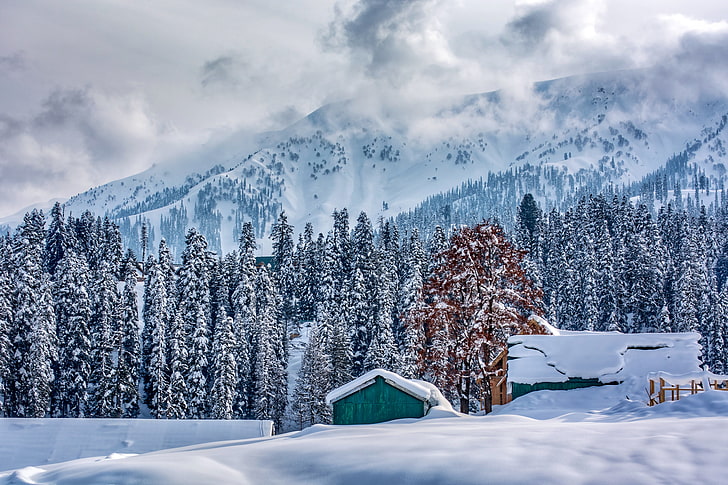Kashmir, a paradise on earth, charming with its majestic mountains, calm lakes, and vibrant culture. From the peaceful Dal Lake to the snow-capped peaks of Gulmarg, every corner tells a story of beauty and resilience.
Explore the bustling markets of Srinagar, savor the warmth of Kashmiri hospitality, and embark on unforgettable adventures. But beyond its picturesque landscapes lies a region with its own complexities and challenges, adding depth to its allure. Kashmir is not just a destination, it’s an experience that touches your soul.
Kashmir is also called “Heaven on Earth”.
Best Time to Visit Kashmir:
The best time to visit Kashmir is during the spring and summer months, from April to June, when the weather is deliciously warm and the valleys are adorned with blooming flowers.
Another best month to visit kashmir is in the autumn, from September to November, when the landscape transforms into a canvas of vibrant colors.
However, it’s important to consider the region’s political situation and weather forecasts before planning your trip. Regardless of the season, Kashmir’s natural beauty and cultural richness promise an unforgettable experience for every traveler.
Let’s find top 7 best places to visit in Kashmir.
1. Gulmarg

Gulmarg, situated in the heart of the Pir Panjal range, is a scenic town in the Baramulla district of Jammu and Kashmir, India. Known for its exceptional beauty and adventure sports, Gulmarg attracts tourists from around the world throughout the year.
Location: Gulmarg is located approximately 50 kilometers from Srinagar, the capital city of Jammu and Kashmir. It sits at an elevation of 2,650 meters above sea level, surrounded by snow-capped peaks and dense forests.
Weather: The weather in Gulmarg varies significantly throughout the year. Summers (April to June) are mild and pleasant, with temperatures ranging from 10°C to 25°C. The Monsoon season (July to September) brings moderate to heavy rainfall, adding to the region’s lush greenery. Winter (November to February) transforms Gulmarg into a winter wonderland, with temperatures dropping below freezing and heavy snowfall blanketing the landscape.
Attractions:
- Gulmarg Gondola: One of the tallest cable cars in the world, offering breathtaking views of the Himalayas.
- Skiing and Snowboarding: Gulmarg is a paradise for winter sports enthusiasts, with clean slopes and powder snow.
- Alpather Lake: A pretty alpine lake surrounded by snow-capped peaks, perfect for a scenic trek.
- Golf Course: Gulmarg boasts the highest golf course in the world, set against the backdrop of stunning mountains.
- Khilanmarg: A beautiful meadow carpeted with wildflowers in the summer and snow in the winter, accessible via a short trek or horse ride.
Accommodation:
Gulmarg offers a range of accommodation options to suit every budget and preference, including hotels, guesthouses, and luxury resorts. Many accommodations provide stunning views of the surrounding mountains and easy access to outdoor activities.
Activities:
Apart from skiing and snowboarding, visitors to Gulmarg can give way to hiking, mountain biking, horse riding, and golfing. There are also opportunities for bird watching, nature walks, and photography with the region’s natural beauty.
2. Pahalgam
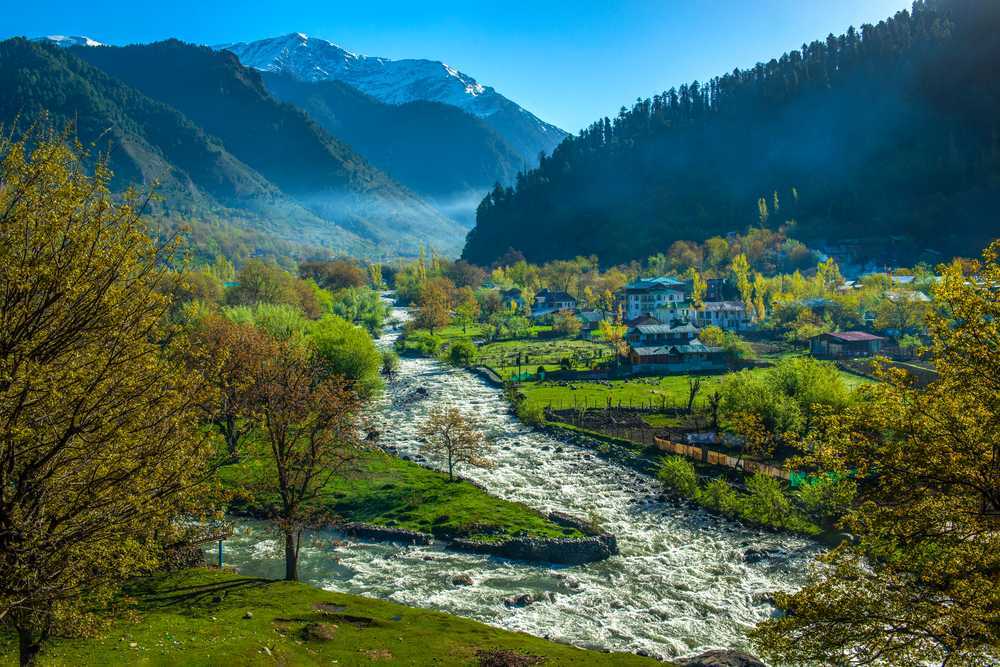
Pahalgam, often referred to as the “Valley of Shepherds,” is an attractive town located in the Anantnag district of Jammu and Kashmir, India. Situated at an altitude of 2,130 meters above sea level, Pahalgam is renowned for its stunning natural beauty, rich green valleys, and pristine rivers.
Location:
Pahalgam is nestled along the banks of the Lidder River, approximately 95 kilometers east of Srinagar, the capital city of Jammu and Kashmir. It is easily accessible by road and serves as the gateway to the famous Amarnath Yatra pilgrimage route.
Weather:
The weather in Pahalgam varies with the seasons. Summers (April to June) are mild and pleasant, with temperatures ranging from 8°C to 25°C. The Monsoon season (July to September) brings moderate to heavy rainfall, enhancing the region’s verdant landscapes. Winters (November to February) are cold and snowy, with temperatures often dropping below freezing.
Attractions:
- Betaab Valley: Named after the Bollywood movie “Betaab,” this attractive valley offers stunning views of snow-capped mountains, pretty meadows, and the Lidder River.
- Aru Valley: Known for its scenic beauty and pristine landscapes, Aru Valley is a paradise for nature lovers and trekkers.
- Chandanwari: The starting point of the Amarnath Yatra pilgrimage, Chandanwari is also a popular picnic spot and base for hiking expeditions.
- Lidder River: Visitors can enjoy leisurely walks along the banks of the Lidder River, go trout fishing, or indulge in adventurous activities like river rafting.
- Trekking and Adventure Sports: Pahalgam offers numerous hiking trails, including the famous trek to Kolahoi Glacier. Adventure enthusiasts can also enjoy activities like horse riding, golfing, and paragliding.
Accommodation:
Pahalgam offers a range of accommodation options, including hotels, guesthouses, resorts, and campsites. Many accommodations provide stunning views of the surrounding mountains and easy access to outdoor activities.
Local Cuisine: Visitors to Pahalgam can savor delicious Kashmiri cuisine, including traditional dishes like Rogan Josh, Dum Aloo, and Kashmiri Pulao. The town also boasts a variety of eateries serving Indian, Continental, and Chinese cuisine.
3. Dal Lake
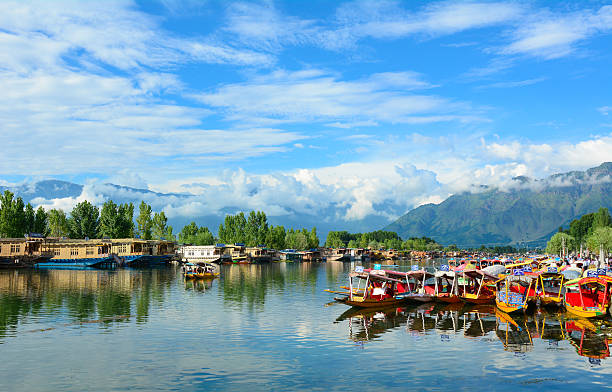
Dal Lake, often referred to as the “Jewel in the Crown of Kashmir,” is a mesmerizing water body located in Srinagar, the summer capital of Jammu and Kashmir, India. It is one of the most iconic and pretty destinations in the region, known for its serene beauty, floating gardens, and houseboats.
Location:
Dal Lake is situated in the heart of Srinagar, surrounded by the majestic Himalayas. It covers an area of approximately 18 square kilometers and is fed by numerous mountain streams and springs.
Scenic Beauty:
The lake is renowned for its stunning scenery, with crystal-clear waters reflecting the snow-capped peaks of the surrounding mountains. Lush green gardens, vibrant lotus blooms, and floating vegetable markets add to its charm, creating a tranquil oasis amidst the bustling city.
Houseboats:
One of the unique features of Dal Lake is its vibrant houseboat community. These beautifully decorated houseboats, known as “shikaras,” offer a unique and immersive way to experience life on the lake. Visitors can stay in these floating accommodations and enjoy breathtaking views of the lake and its surroundings.
Shikara Rides:
Exploring Dal Lake on a shikara ride is a must-do experience for visitors. These traditional wooden boats glide gracefully across the lake, allowing travelers to soak in the beauty of their surroundings. Shikara rides often include visits to the floating gardens, vegetable markets, and historic sites around the lake.
Floating Gardens and Markets:
Dal Lake is famous for its floating gardens, known as “raadh,” where locals cultivate vegetables and flowers. Visitors can witness the unique farming practices and even purchase fresh produce directly from the floating vendors. The lake also hosts a vibrant floating market, where vendors sell a variety of goods from their boats.
Water Activities:
In addition to shikara rides, Dal Lake offers a range of water activities for visitors to enjoy. These include kayaking, canoeing, and paddle boating, allowing travelers to explore the lake at their own pace and experience its peace up close.
Sunset Views: Sunset is a magical time on Dal Lake, as the golden hues of the setting sun bathe the lake in a warm glow. Travelers can witness breathtaking sunset views from the comfort of their houseboats or during a leisurely shikara ride on the lake.
4. Sonamarg
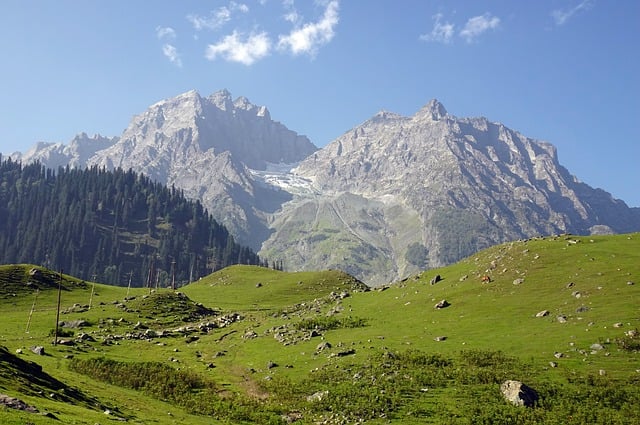
Sonamarg, translating to “Meadow of Gold,” is a breathtaking hill station nestled in the Ganderbal district of Jammu and Kashmir, India. Situated at an altitude of around 2,800 meters above sea level, Sonamarg is renowned for its stunning landscapes, alpine meadows, and snow-capped peaks.
Location:
Sonamarg is located approximately 80 kilometers north-east of Srinagar, the summer capital of Jammu and Kashmir. It lies along the Srinagar-Leh Highway, making it easily accessible by road.
Scenic Beauty:
The natural beauty of Sonamarg is unparalleled, with lush green valleys, shining glaciers, and cascading waterfalls dotting the landscape. The Sind River curves through the region, adding to its picturesque charm.
Glaciers and Lakes:
Sonamarg serves as the gateway to several glaciers and high-altitude lakes, including the famous Thajiwas Glacier. Visitors can embark on treks or pony rides to reach these pristine destinations and marvel at the beauty of their icy expanses.
Adventure Activities:
Sonamarg is a paradise for adventure enthusiasts, offering a wide range of activities: hiking, camping, and white-water rafting. The region’s rugged terrain and majestic peaks provide the perfect backdrop for thrilling adventures.
Thajiwas Glacier:
One of the main attractions of Sonamarg is the Thajiwas Glacier, located just a few kilometers from the town. Visitors can trek or take a pony ride to reach the glacier and witness its shimmering ice formations and panoramic views of the surrounding mountains.
Baltal Base Camp:
Sonamarg serves as the base camp for the annual Amarnath Yatra pilgrimage to the holy Amarnath Cave. The Baltal Base Camp, located near Sonamarg, is the starting point for the shorter and more challenging trek to the cave.
Local Culture and Cuisine:
The vibrant culture of Sonamarg reflects the rich heritage of Kashmiri traditions. Visitors can interact with locals, experience their hospitality, and savor traditional Kashmiri cuisine at local eateries and restaurants.
Weather: Sonamarg experiences cold weather throughout the year, with temperatures dropping significantly in the winter months. Summers (May to September) are mild and pleasant, making it the ideal time to visit. The monsoon season (July to September) brings rainfall, while winters (November to February) see heavy snowfall, transforming the region into a winter wonderland.
5. Srinagar
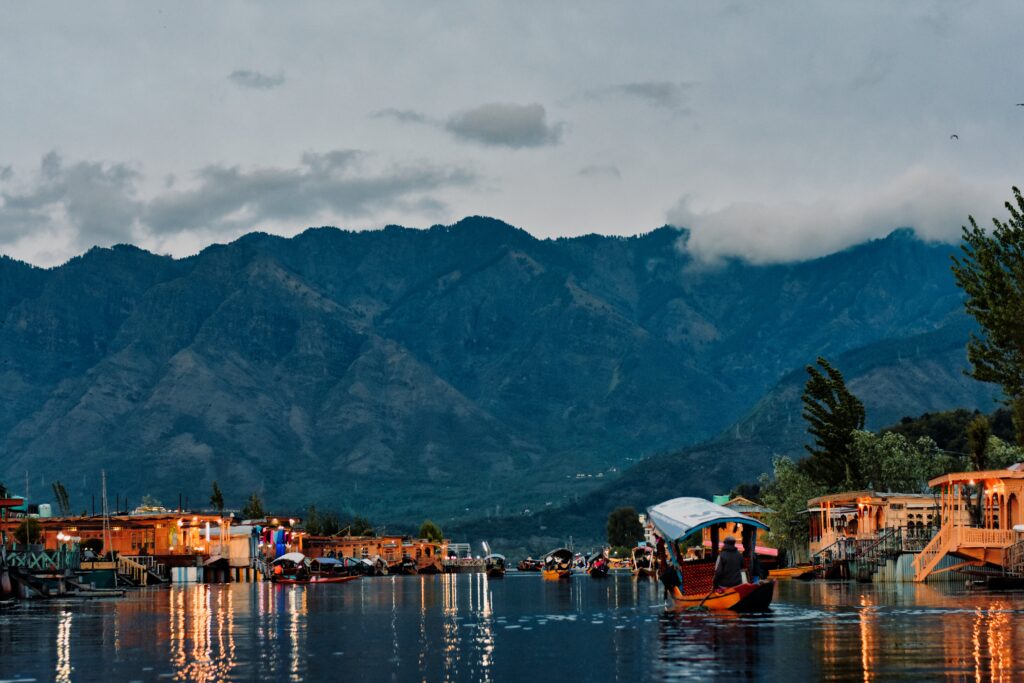
Srinagar, the summer capital of Jammu and Kashmir, is a city steeped in history and natural beauty. Situated in the Kashmir Valley, Srinagar is renowned for its picturesque landscapes, serene lakes, and Mughal gardens.
Location:
Srinagar is located in the heart of the Kashmir Valley, surrounded by the majestic Himalayas. It is situated along the banks of the Jhelum River, which flows through the city, adding to its scenic charm.
Scenic Beauty:
Srinagar is blessed with breath-taking natural beauty, with snow-capped peaks, lush green valleys, and crystal-clear lakes dotting its landscape. The iconic Dal Lake, with its shimmering waters and colorful houseboats, is a symbol of the city’s timeless allure.
Mughal Gardens:
Srinagar is home to several exquisite Mughal gardens, including Shalimar Bagh, Nishat Bagh, and Chashme Shahi. These meticulously manicured gardens are adorned with terraced lawns, vibrant flowers, and cascading fountains, offering a serene retreat amidst nature.
Dal Lake:
Dal Lake is the centrepiece of Srinagar’s beauty, offering a unique and immersive experience for visitors. Travellers can enjoy shikara rides on the lake, explore its floating gardens and markets, and witness breath-taking sunsets from the comfort of a houseboat.
Houseboats:
Staying in a traditional houseboat on Dal Lake is a typical Srinagar experience. These complicated, decorated floating homes offer a glimpse into the city’s rich cultural heritage and provide a calm oasis away from the hustle and bustle of city life.
Old City:
The Old City of Srinagar is a maze of narrow alleys, bustling bazaars, and historical landmarks. Visitors can explore ancient mosques, vibrant markets, and quaint cafés, immersing themselves in the city’s rich cultural tapestry.
Local Cuisine:
Srinagar is known for its delectable Kashmiri cuisine, which features aromatic spices, hearty meat dishes, and flavorful rice preparations. Visitors can sample local delicacies like Rogan Josh, Yakhni, and Wazwan at traditional Kashmiri restaurants and eateries.
Weather:
Srinagar experiences four distinct seasons, with each offering its own unique charm. Summers (April to June) are mild and pleasant, making it the ideal time to visit. The monsoon season (July to September) brings occasional rainfall, while autumn (October to November) paints the city in hues of gold and red. Winters (December to February) see heavy snowfall, transforming Srinagar into a winter wonderland.
6. Pulwama
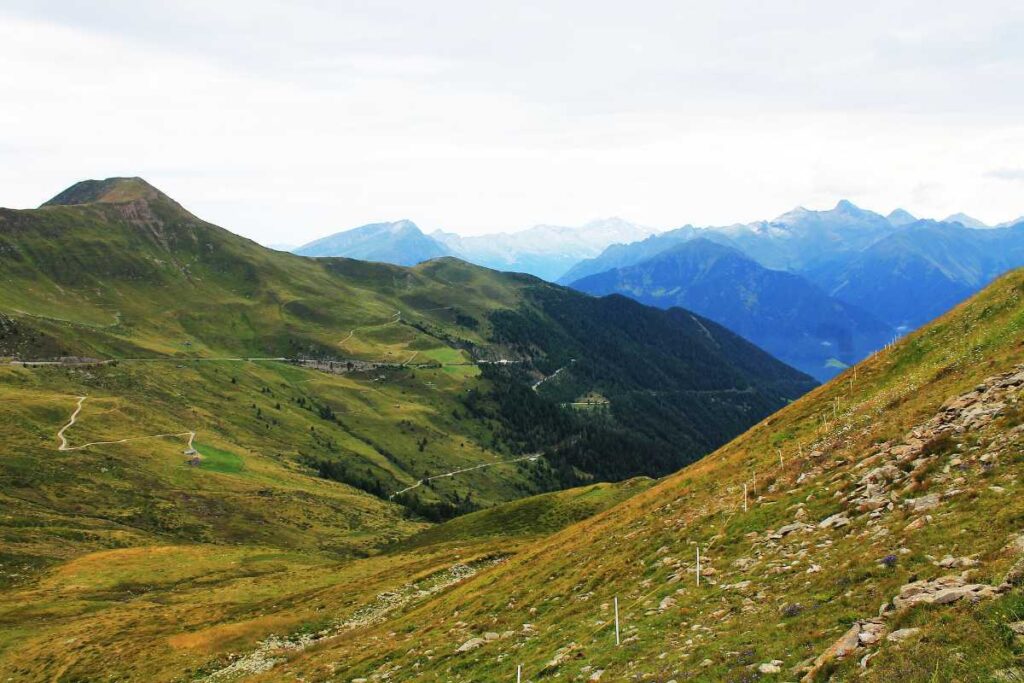
Pulwama, located in the southern part of the Kashmir Valley, is an attractive district renowned for its natural beauty, rich cultural heritage, and vibrant agricultural landscape.
Location:
Pulwama is situated approximately 40 kilometers south of Srinagar, the summer capital of Jammu and Kashmir. It is bordered by the districts of Anantnag and Shopian to the west and north, respectively.
Scenic Beauty:
Pulwama is blessed with breath-taking natural beauty, with snow-capped mountains, lush green meadows, and blooming orchards adorning its landscape. The region is known for its iconic saffron fields, which paint the countryside in the shade of purple during the harvest season.
Agriculture:
Pulwama is often referred to as the “Rice Bowl of Kashmir” due to its fertile soil and abundant water sources. The district is a major producer of rice, apples, and saffron, contributing significantly to the region’s agricultural economy.
Tourist Attractions:
Pulwama boasts several tourist attractions, including the famous Aharbal Waterfall, Tarsar and Marsar Lakes, and the scenic Shikargah Wildlife Sanctuary. Visitors can also explore the historic ruins of Avantipur and the charming village of Pampore, known for its saffron cultivation.
Outdoor Activities:
The attractive landscapes of Pulwama offer ample opportunities for outdoor activities such as hiking, camping, and bird watching. The region’s pristine lakes and rivers provide ideal spots for fishing and boating, while the surrounding mountains offer thrilling hiking trails.
Cultural Heritage:
Pulwama is home to a rich cultural heritage, with influences from Kashmiri, Mughal, and Persian traditions. Visitors can explore ancient temples, shrines, and mosques, as well as vibrant markets and handicraft shops showcasing local artistry.
Weather:
Pulwama experiences four distinct seasons, with each offering its own unique charm. Summers (April to June) are mild and pleasant, making it the ideal time to visit. The monsoon season (July to September) brings occasional rainfall, while autumn (October to November) offers stunning views of colorful foliage. Winters (December to February) see cold temperatures and occasional snowfall, creating a picturesque winter landscape.
7. Gurez valley
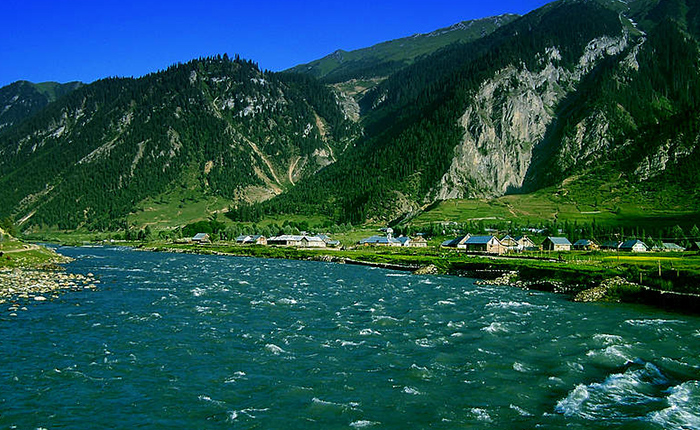
Gurez Valley, nestled in the northern part of the Kashmir Valley, is a remote and clean region known for its stunning landscapes, rich cultural heritage, and unique way of life.
Location:
Gurez Valley is situated in the northernmost part of the Kashmir Valley, near the Line of Control (LoC). It is bordered by the districts of Bandipora and Kupwara to the south and west, respectively.
Scenic Beauty:
Gurez Valley is renowned for its breath-taking natural beauty, with towering mountains, lush green meadows, and glistening rivers defining its landscape. The region is surrounded by snow-capped peaks, including the famous Habba Khatoon mountain range, adding to its picturesque charm.
Isolation and Accessibility:
Gurez Valley is relatively isolated and accessible only via a single road that traverses through mountainous terrain. The road remains closed during the winter months due to heavy snowfall, making access to the valley challenging and limited.
Cultural Heritage:
The residents of Gurez Valley, mostly of Dard descent, have a rich cultural heritage that dates back centuries. They have preserved their unique customs, traditions, and way of life, which are reflected in their language, attire, and cuisine.
Tourist Attractions:
Gurez Valley offers several tourist attractions, including the scenic Dawar town, the lovely Wular Lake, and the historic Kishanganga River. Visitors can explore traditional villages, ancient mosques, and ruins dating back to the Mughal era.
Outdoor Activities:
The pristine landscapes of Gurez Valley provide ample opportunities for outdoor activities such as hiking, camping, and bird watching. The region’s rivers and streams offer excellent fishing spots, while the surrounding mountains are ideal for hiking and mountaineering.
Weather:
Gurez Valley experiences harsh winters with heavy snowfall, making it inaccessible for much of the year. Summers (June to September) are brief but pleasant, with mild temperatures and clear skies. The monsoon season (July to September) brings occasional rainfall, while autumn (October to November) offers stunning views of colorful foliage.
For Tour Packages you can visit Here
For More : Click Here

